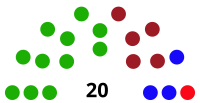| Kolonnawa Urban Council | |
|---|---|
| Type | |
| Type | Local Authority |
| History | |
| Founded | 1930; 95 years ago (1930) |
| Structure | |
| Seats | 20 |
 | |
| Political groups | Government
Opposition |
| Elections | |
| Voting system | Mixed |
| Last election | 10 February 2018 |
| Next election | 2022 |
Kolonnawa Urban Council (Sinhala: කොලොන්නාව නගර සභාව, Tamil: கொலோனாவா நகர சபை) is the local authority for Kolonnawa and surrounding suburbs in Sri Lanka. It has 20 members elected under the mixed electoral system where 60% of members are elected using first-past-the-post voting and the remaining 40% through closed list proportional representation.
History
Originally created in 1930, the Kolonnawa Urban Council came into being as a hub for warehousing and service sector for the nearby Port of Colombo. Traders and retailers working in the various city markets, as well as low-income workers engaged in shipping-related activities were the mainstay of the Kolonnawa populace. In addition to residential areas, a large volume of industrial and commercial buildings such as stores, warehouses, container yards, electricity distribution infrastructure (including the Kelanitissa Power Station) and the Ceylon Petroleum Storage Terminal (Kolonnawa Refinery) are located in the Kolonnawa area.
Geography
The Kolonnawa Urban Council lies on the Southern bank of the Kelani River and covers an area of about 10.06 km (3.88 sq mi) in extent. Mostly lying in the flood plain of the Kelani River, 70% of the land lies below Sea level. A Flood control dam constructed in 1935 (named the Harward Bund) protects the area south of it from flooding of the river.
The Council is bounded to the West by the Colombo Municipal Council, to the South by Sri Jayawardenapura Kotte Municipal Council, and to the East by the Mulleriyawa Pradeshiya Sabha.
Wards
For electoral and administrative purposes, the Council is divided into 9 wards:
- Sedawatta
- Wadulla
- Orugodawatta
- Wellampitiya
- Dahampura
- Kolonnawa
- Singhapura
- Salamulla
- Gajabapura
Demographics
Kolonnawa Urban Council is a multi-religious, multi-ethnic, multi-cultural area. The population fell from 57,984 in 1981 to 55,285 in 2001.
Population by Religion (2001)
Buddhists (54.6%) Muslims (21.2%) Hindus (16.4%) Christians (7.7%) Other (0.1%)| Population (2001) | % of Total | |
|---|---|---|
| Buddhism | 30,200 | 54.6% |
| Islam | 11,756 | 21.2% |
| Hinduism | 9,069 | 16.4% |
| Christianity | 4,246 | 7.7% |
| Other | 14 | 0.1% |
| Total | 55,285 | 100.00% |
References
- ^ "Local Authority - Kolonnawa Urban Council". Ada Derana. Retrieved 7 November 2020.
- Dissanayake, Chathuri (5 December 2017). "LG polls cost to hit Rs. 4 b". Daily FT. Colombo, Sri Lanka. Retrieved 23 December 2017.
- Marasinghe, Sandasen; Mudalige, Disna (25 August 2017). "Amended Local Government Elections Bill approved in Parliament". Daily News. Colombo, Sri Lanka.
- ^ "CITY PROFILE Kolnonnawa Urban Council" (PDF). UNDP / UN-Habitat - Sustainable Cities Programme (SCP). Retrieved 7 November 2020.
- ^ "Ward Map of Kolonnawa Urban Council - Colombo District" (PDF). Survey Department of Sri Lanka. Retrieved 7 November 2020.
External links
- Urban Development Authority - Kolonnawa Zoning Plan
- Ward Map of Kolonnawa Urban Council - Colombo District
| Places adjacent to Kolonnawa Urban Council | ||||||||||||||||
|---|---|---|---|---|---|---|---|---|---|---|---|---|---|---|---|---|
| ||||||||||||||||